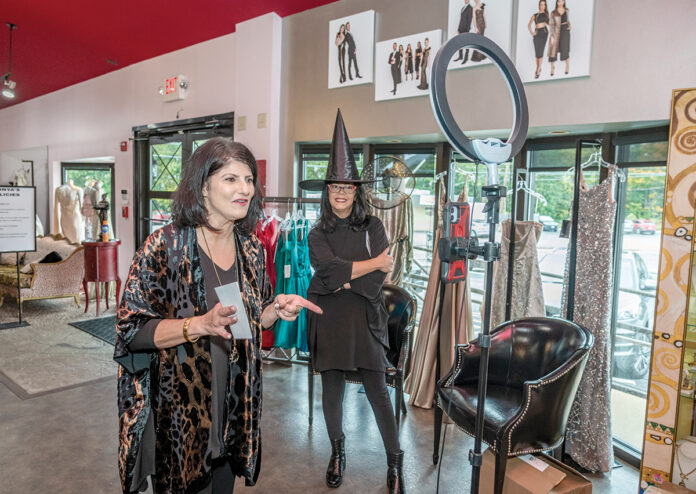Sonya Janigian is not your typical social media influencer.
But in the last 18 months, livestreamed Facebook videos have become a fixture of her Cranston clothing business, a source for promoting events, sales and new stock, and reaching a growing audience of potential customers. She’s even developed a signature greeting, starting each video by welcoming viewers to Sonya’s Clothing, “live and in color from beautiful Cranston.”
“People love the familiarity of it,” she said. “We get messages asking when our next video is.”
Indeed, social media has become a staple of doing business, not just for marketing and talking to customers, but even for direct sales. A 2021 study by consumer data company Statista projected revenue from social commerce would more than double in the next four years, increasing from $36 billion to $79 billion by 2025.
But the rosy glow of social media has a dark side, too, as some entrepreneurs experienced firsthand when Facebook, Instagram and related platforms under the new Meta Platforms Inc. went down for nearly a day on Oct. 4. The outage cost Mark Zuckerberg’s company an estimated $100 million in revenue, according to some estimates. That’s a drop in the bucket relative to its $29.1 billion second-quarter earnings, but for small businesses that rely on these platforms to connect to customers and sell products, the loss of service was painful.
Janigian was not among them. She did not even notice the platforms were down, she says. As a longtime business owner – she started the boutique in 1983 – her business was built long before Instagram and TikTok even existed.
‘They don’t realize the time it takes to do social media well.’
KRISTEN REGINE, Johnson & Wales University marketing professor
That’s not the case for many newer businesses, particularly those started by younger entrepreneurs whose upbringing was accompanied by likes, shares and reposts. Mahran Izoli and his wife, Nur Shahida Roslan, started their gourmet cookie business, Feed the Cheeks Inc., from Roslan’s Instagram account. For nearly the first year of the business, Instagram was the sole way the millennial Providence couple could market, and sell, their giant 6-ounce cookies.
They never had any problems relying on the platform, Izoli said. In fact, Instagram was a huge part of their early business success, with reposts by family and friends helping them grow a customer base quickly and cheaply.
“It really just blew up,” Izoli said.
That initial demand gave them the confidence to expand, justifying the cost of renting a storefront in Providence’s Wayland Square and launching a website in February 2020. They are planning to add a second kitchen later this year and expand what is still a “bare bones” webpage to include an e-commerce platform, Izoli said.
While social media platforms can break down the barriers to entry for new entrepreneurs, too little investment in other channels can mean not much in return, warned Kristen Regine, a marketing professor at Johnson & Wales University. Not only do these platforms leave business owners at the mercy of another company, they still require a well-planned strategy to be effective, Regine said.
“The biggest misstep for small businesses is they don’t realize the time it takes to do social media well,” she said. “If you’re willing to spend thousands of dollars in advertising as a percentage of sales, why would you not want to be as fully in control and knowledgeable about it as possible?”
It is for that reason that Amber Jackson, owner of The Black Leaf Tea & Culture Shop, just hired her first employee to manage the shop’s Facebook, Instagram and TikTok pages. Jackson, a millennial who came of age in the era of Myspace and Facebook, has always understood the value of social media, starting Facebook and Instagram pages for her business at the same time she opened in 2019. But she had her own website, e-commerce store and email list to rely on, too.
“It’s the most direct and most immediate source of connection to your customers,” Jackson said of social media.
And those connections have turned into dollars. While she doesn’t sell directly through Facebook or Instagram, Jackson estimated 30% to 40% of the traffic on her e-commerce page comes from social media platforms.
Janigian, who earlier this year added a new e-commerce platform that syncs items posted on her business social media pages back to the shop, wasn’t yet seeing that kind of payoff in sales. But she was confident it would come.
“We’re starting to see our social media snowball a bit,” she said. “That doesn’t necessarily turn into instantaneous sales, but we’re paving the path, so down the road it’s familiar. When someone is thinking of buying a prom dress or sportswear, they remember us.”
In the meantime, she was happy to continue honing her social media strategy, experimenting on different settings or types of posts and videos to see what worked best. Already, she’s grown more comfortable in front of the camera.
“It was a little daunting at first,” Janigian said. “I am the least savvy when it comes to technology. It is not my strong suit. But knowing my product and knowing my customers is my strong suit.”
Nancy Lavin is a PBN staff writer. Contact her at Lavin@PBN.com.












